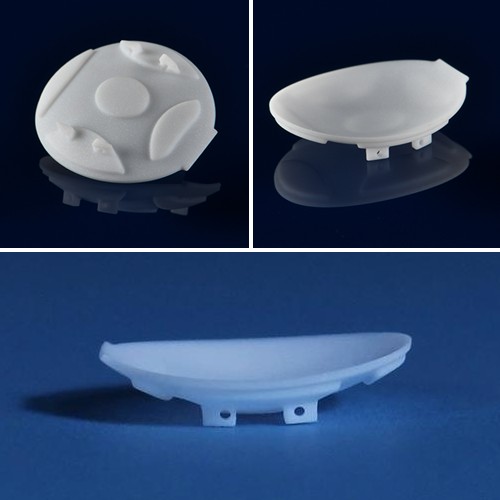Macor ceramics eye stents parts
Alias: Machinable glass-ceramic precision fixed bracket
Description:
In the medical field, ceramic eye stents serve as essential medical components. The artificial eye made of Macor ceramic material developed by Corning Inc, significantly reduces the risk of postoperative complications. The Macor material is non-toxic, odorless, and exhibits excellent biocompatibility. It demonstrates stable functionality within the complex physiological environments of the human body and is minimally influenced by endocrine substances.
The exceptional mechanical performance and strength of the ceramic material, enable it to withstand various forces encountered during surgical procedures, thereby ensuring safety and reliability.
Furthermore, Macor ceramics offer significant value in clinical practice within the healthcare sector.
Corneal transplantation surgery serves to facilitate corneal reconstruction and enhance vision recovery, as well as to support refractive surgery. In procedures addressing myopia and hyperopia, personalized eye stents are utilized to aid in stabilizing the surgical outcomes.

The rapid advancement of healthcare and technology has led to the growing application of Macor ceramics across various industries. Since 2019, Fudong Machinery has been supplying efficient and high-precision processing tailored for diverse sectors, alongside customized processing services for machinable microcrystalline glass. The company is dedicated to fulfilling the product quality requirements of its customers.
Key Characteristics:
Machinable ceramic precision parts are key components in the field of modern precision machining, widely used in industries such as electronics, aerospace, medical, automotive, and industrial equipment. Its key features include:
1. Macor has a pore free microstructure, making it impermeable to gases and liquids. Performed well in Ultra High Vacuum.
2. No sintering or further heat treatment is required, reducing manufacturing costs.
3. Can be used in combination with other materials such as metal and glass.
4. Not easy to creep or deform at high temperatures, with good dimensional stability.
5. Electrical Insulation: ——Excellent electric insulator material, it is an ideal material for electronic components and high-voltage applications. In the electronics and aerospace sectors, this characteristic is essential for applications in high-pressure and high-temperature environments. The high resistivity of Macor, measured at 1016Ω·cm, renders it an exceptional electrical insulator, even under elevated thermal conditions.
6. Low thermal expansion coefficient. The coefficient of thermal expansion matches many metals and sealing glasses.
7. Chemical Resistance: ——Has strong resistance to various chemical substances, including acids, bases, solvents, and gases. In corrosive environments, Macor exhibits inertness to the majority of acids, bases, and solvents.
8. Thermal Performance: ——Capable of continuous operation at temperatures up to 800 ° C, with a peak operating temperature of 1000 ° C under no-load conditions. Macor can endure temperatures of up to 1000 °C, rendering it appropriate for applications that necessitate insulation.
9. High-precision: ——In high-precision and complex applications, Macor can achieve a machining tolerance of 0.0005 inches (0.013 millimeters).
10. Excellent machinability: ——Macor can be machined using standard metal processing tools such as lathes, milling machines, drills, and saws, helping to achieve stringent tolerances with precision levels as low as 0.013 millimeters. This capability contributes to a reduction in both delivery time and production costs for prototypes and customized components.
Applications:
Machinable ceramic parts have a wide range of applications in several high-end industries:
1. Ultra-high vacuum system, vacuum feedthrough and insulator
2. Fixtures, insulators, and precision components in semiconductor equipment
3. Mass spectrometer, ion trap, and low-temperature system
4. Surgical instruments, diagnostic equipment and imaging system components
5. Electric insulators in ion thrusters
6. Electrode holder for plasma generator
7. Structural supports for high-voltage equipment and transformers
8. High voltage components in X-ray tubes
9. Optical components in spectrometers and laser systems
10. High temperature insulation brackets and components in spacecraft and satellites
Product customization:
In the field of precision ceramic processing customization, Fudong Machinery is committed to producing various high-performance ceramic parts to meet the specific needs of different industries, providing customers with high-quality, efficient, and reliable solutions. These ceramic components, including zirconia ceramics, silicon nitride, aluminum nitride and other products, are widely used in key fields such as aerospace, electronics, machinery, military industry, and automobiles due to their excellent thermal stability, electrical insulation, high-temperature stability, and wear resistance.
With years of technology accumulation and manufacturing experience, our products provide customers with comprehensive support with excellent performance and reliability, helping them stand out in the fierce market competition.
Non-standard parts customization, due to different requirements such as product size, material details, processing accuracy, etc., resulting in different costs such as material costs, processing costs, packaging logistics, etc. Please be sure to contact customer service when ordering, provide as much part information (drawings or samples, use environment, etc.) and your requirements (quantity, delivery date, etc.) as much as possible, and we will submit you a specific plan that meets your parts requirements, as well as a preferential quotation. Thank you very much for your interest!






